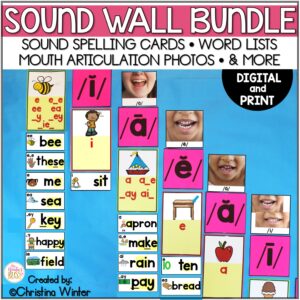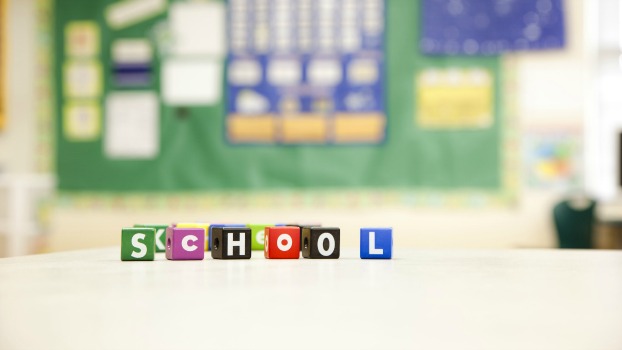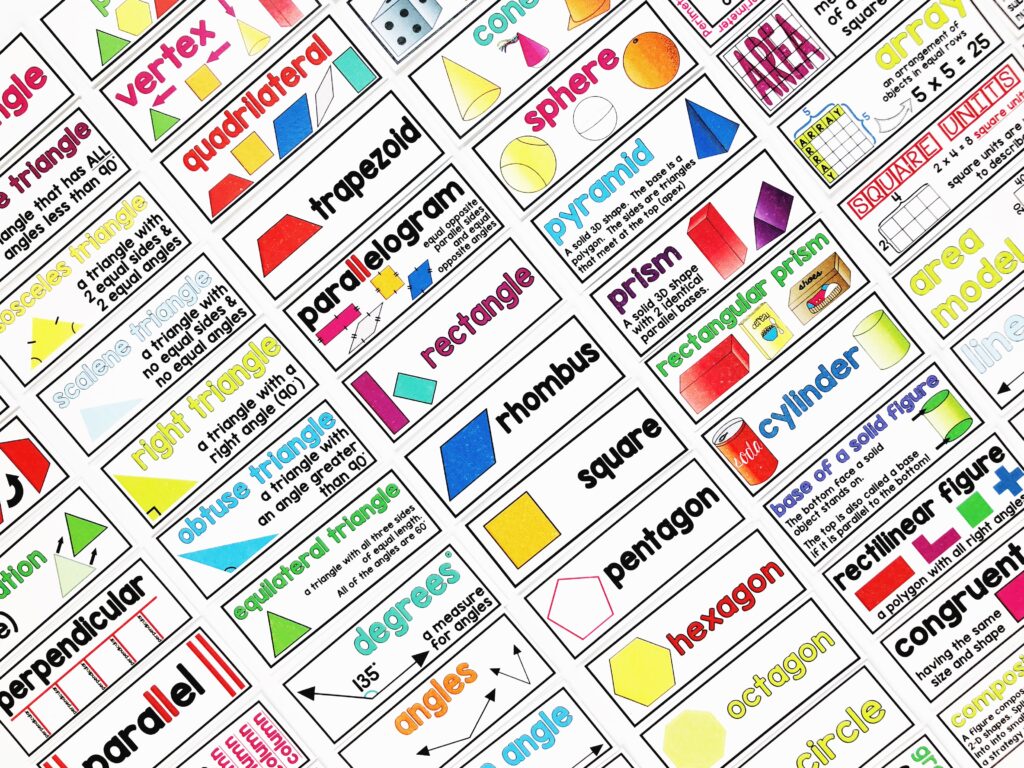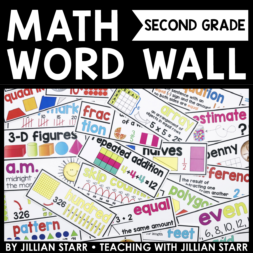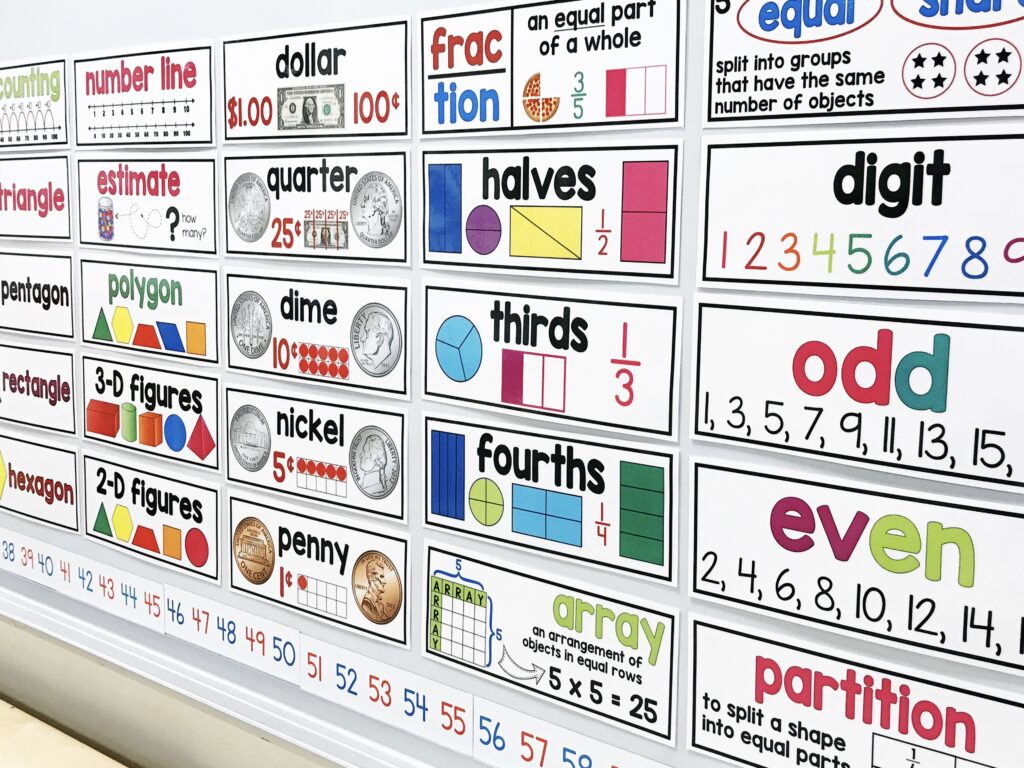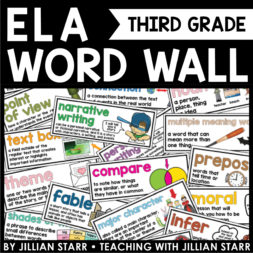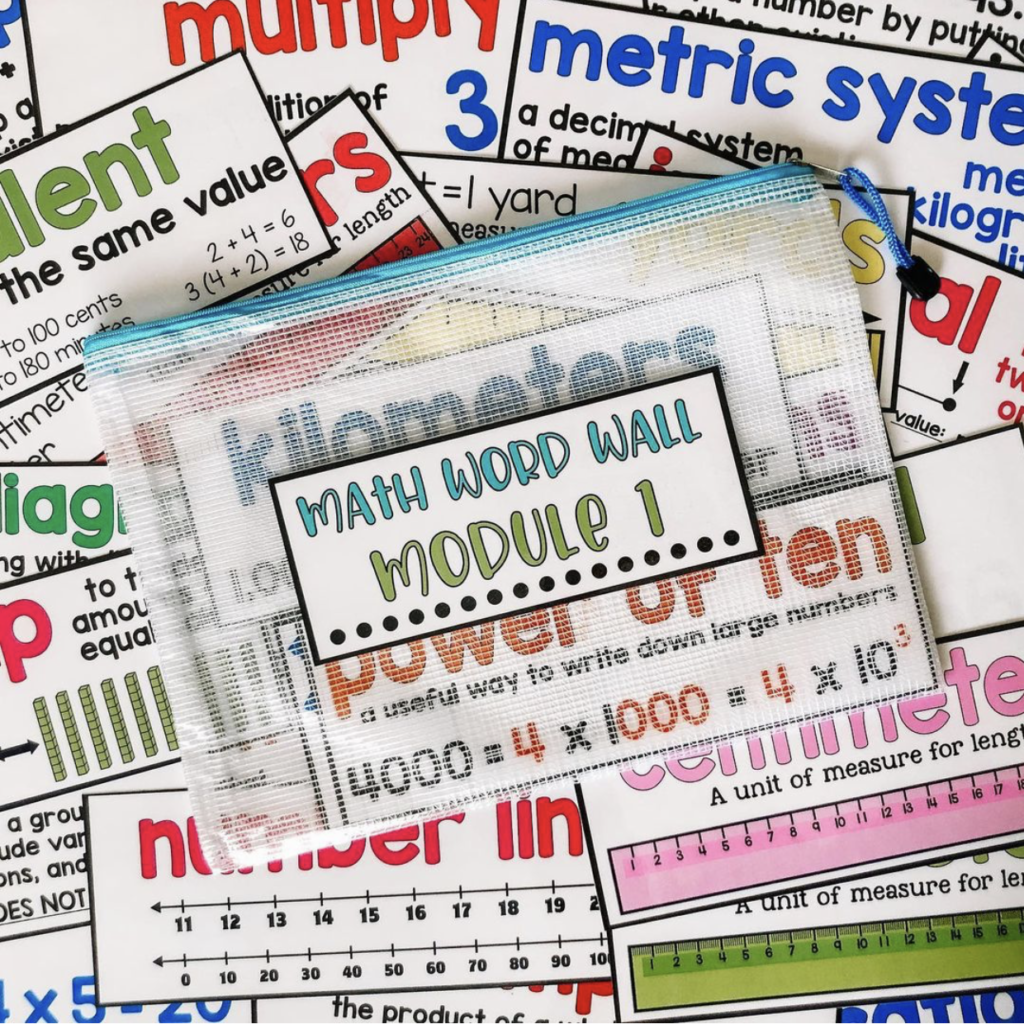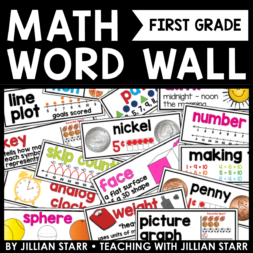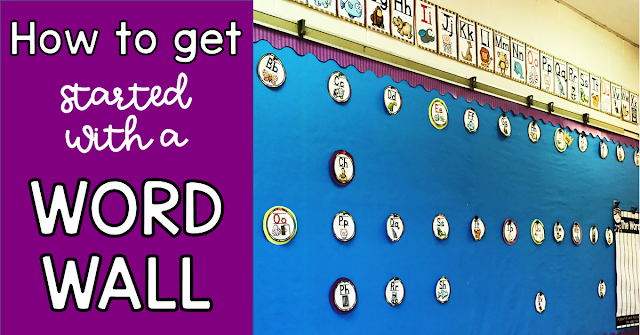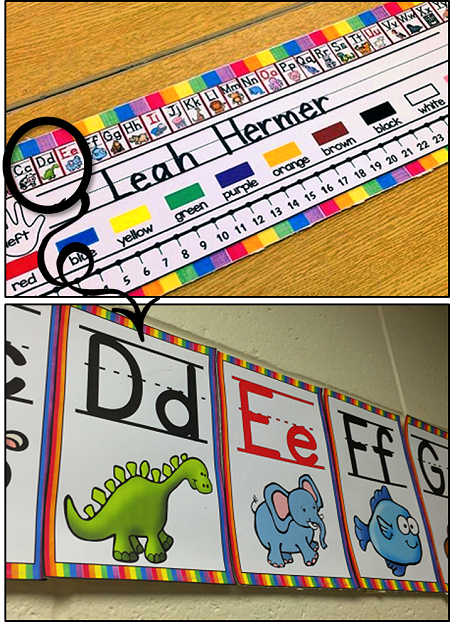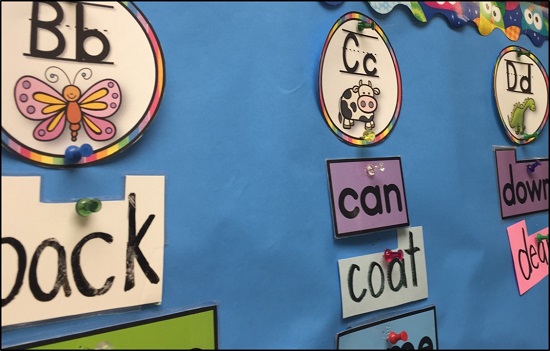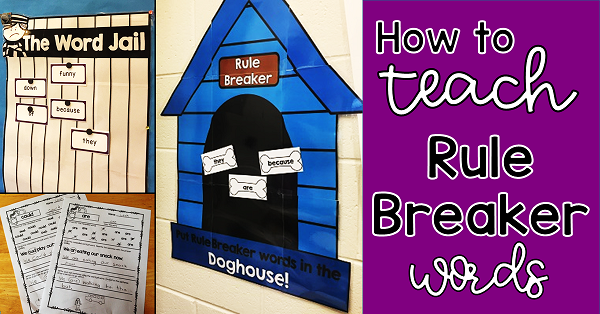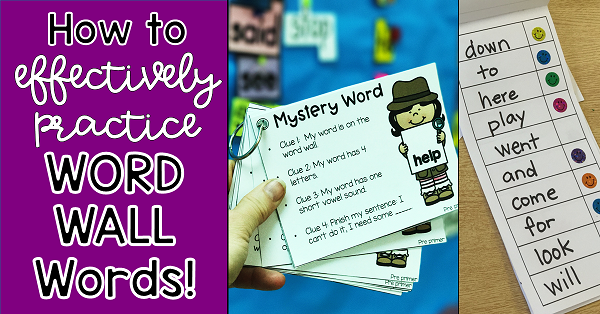In this post I explain why I tore down my traditional word wall and replaced it with a phoneme sound wall. I share the benefits of a sound wall and finally, the Phoneme Sound Wall with Mouth Articulation Photos resource to help teachers create a sound wall in the classroom.
Word walls. You know, the big bulletin boards that contain a collection of high-frequency sight words. Words that students encounter frequently in their reading and writing, as well as words they frequently misspell.
If you are a K-2 teacher, I bet you have one.
Yep, me too. I mean, I had a word wall.
You see, last year I ripped mine off the wall.
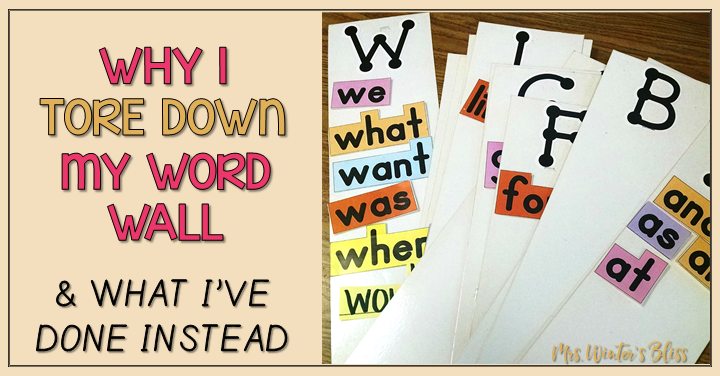
In theory, word walls sound very effective. You introduce a few new words, practice the new words for a week or so, and then slap those puppies up on the word wall! The expectation is that your students will reference them for the remainder of the school year
I followed this practice and had a word wall for years and years and years.
Then last year I ripped it off the wall.
Say what?
Yep, that’s right. I tore down my word wall and replaced it with a sound wall.
What is a Sound Wall?
A sound wall is a way to organize and display the different sounds (or phonemes) we hear in speech. Like a word wall, a sound wall is a place for students to reference when they are spelling and reading words. But UNLIKE a traditional A-Z word wall (where words are grouped by their beginning letter), words on a sound wall are grouped by their sounds.
Another difference is that consonants and vowels are organized separately and in different ways.
A consonant sound wall is organized by the manner of articulation (how the sound is being formed) and the place of articulation (wherein the mouth a sound is occurring).

A vowel sound wall organized by the place of articulation. It is visually represented in the shape of a V or a valley to mimic the change in position of our mouths and shift in our jaw when we produce the different the vowel sounds.
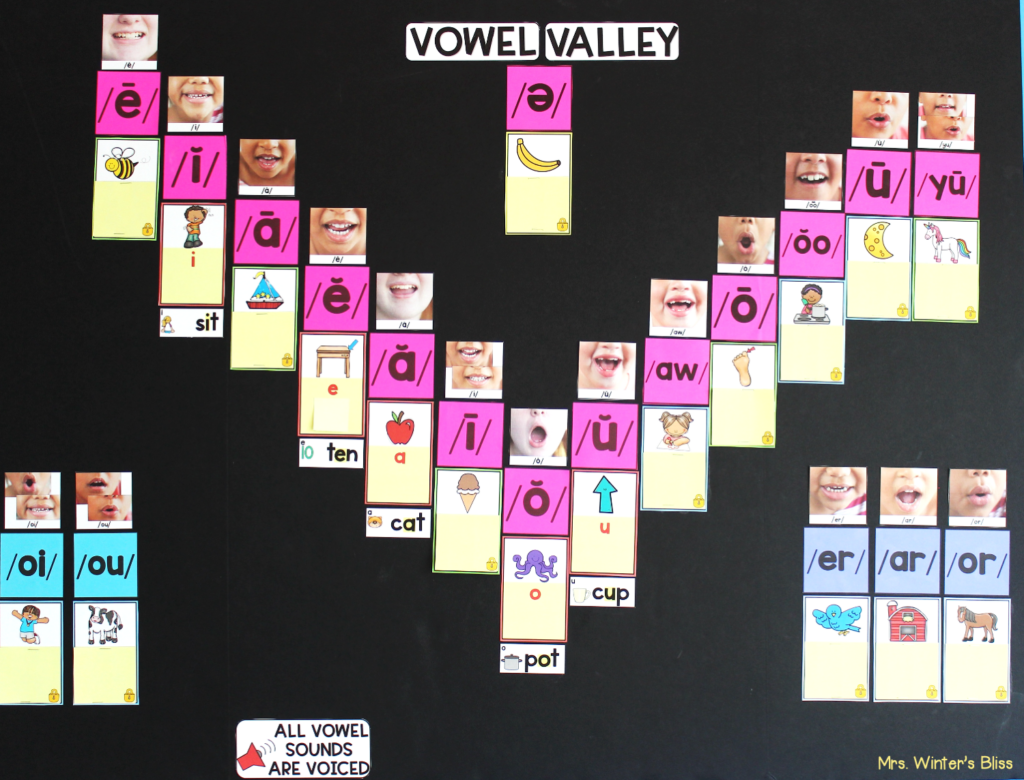
When you see a sound wall you will often find pictures of mouths next to each sound. This helps students better understand what their tongue and mouth are doing when they produce a sound and encourages them to pay attention to the way their mouth feels, looks and acts when they produce different sounds. Mouth pictures are a great support to help students connect the sounds they hear with the print that represents them.

Take a look at this post for more information about how sound walls are organized.
Why I Tore Down My Word Wall and Put Up a Sound Wall
The more I read and learned about sound walls, the more they made sense to me! Here are a few of the main benefits I see to using a sound wall in the classroom:
- Sound walls are based on the science of reading! Research finds that readers make the connection between print patterns and phonological information that is already stored in the brain in order to then make meaning of the word they’re reading (Moats, 2010). This is why explicitly teaching phonemes is necessary before you teach sound-letter correspondence.
- Sound walls approach things from the student’s point of view. A traditional A-Z word wall categorizes words by their first letter. But that doesn’t make sense to someone who is just learning to spell! A student looking for the word phone will not naturally look to P. Putting the word knee under K is confusing to them! A sound wall categorizes words by their sounds which makes much more sense to the learner!
- They allow for explicit instruction of phonemes. Kids learn to talk well before they learn to read or write. This is because our brains are hardwired for oral language, but not for reading and writing. Students need direct and explicit instruction on how to read, write, and spell. A sound wall is a tool that allows for this valuable, explicit phonics instruction.
It became so clear to me that sound walls are a powerful tool to help students learn to read and write! Next, I focused on how I would use a sound wall in my classroom and made a plan for introducing it to my students.
Last, I just needed create all the components of my sound wall. That’s just what I did and now I can share it with you!
Phoneme Sound Wall Resource
A sound wall has a lot of components, but don’t let that overwhelm you! You don’t have to create anything, I’ve already done that for you!
I created the Phoneme Sound Wall with Mouth Articulation Photos resource that has absolutely everything you need to create a sound wall from start to finish! Rather than spending hours creating the materials yourself, you can focus your time on planning and providing smarter phonics instruction to your students. And isn’t that the way it should be??
To get your sound wall started you’ll get phoneme cards and phoneme group labels to organize the sounds on the wall.
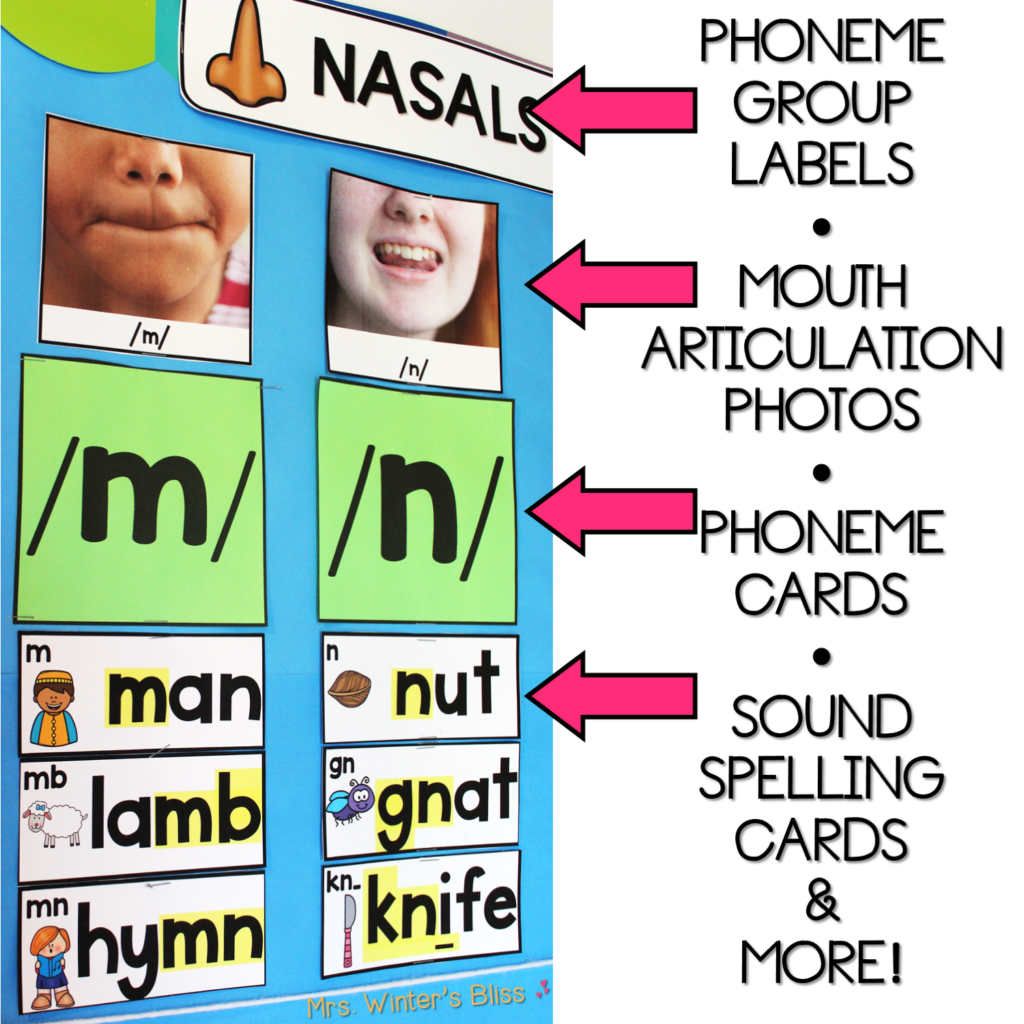
The mouth articulation photos are a wonderful support as you focus on what lips, teeth, and tongue are doing when you produce a sound.
You’ll also get sound spelling cards (both large and small) and sound spelling picture cards to post below each phoneme.
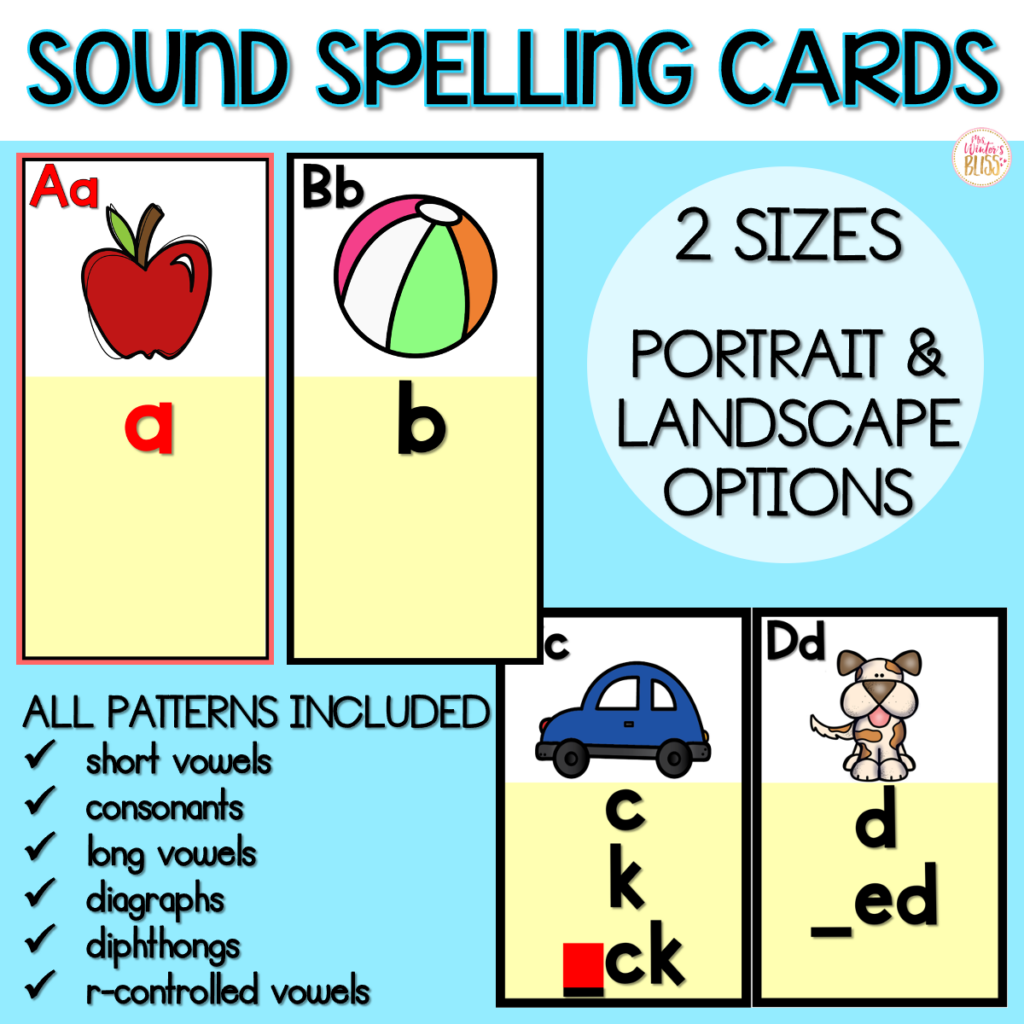
The resource also includes materials for your students! These materials allow you to differentiate and provide the support students need to be independent readers and writers!
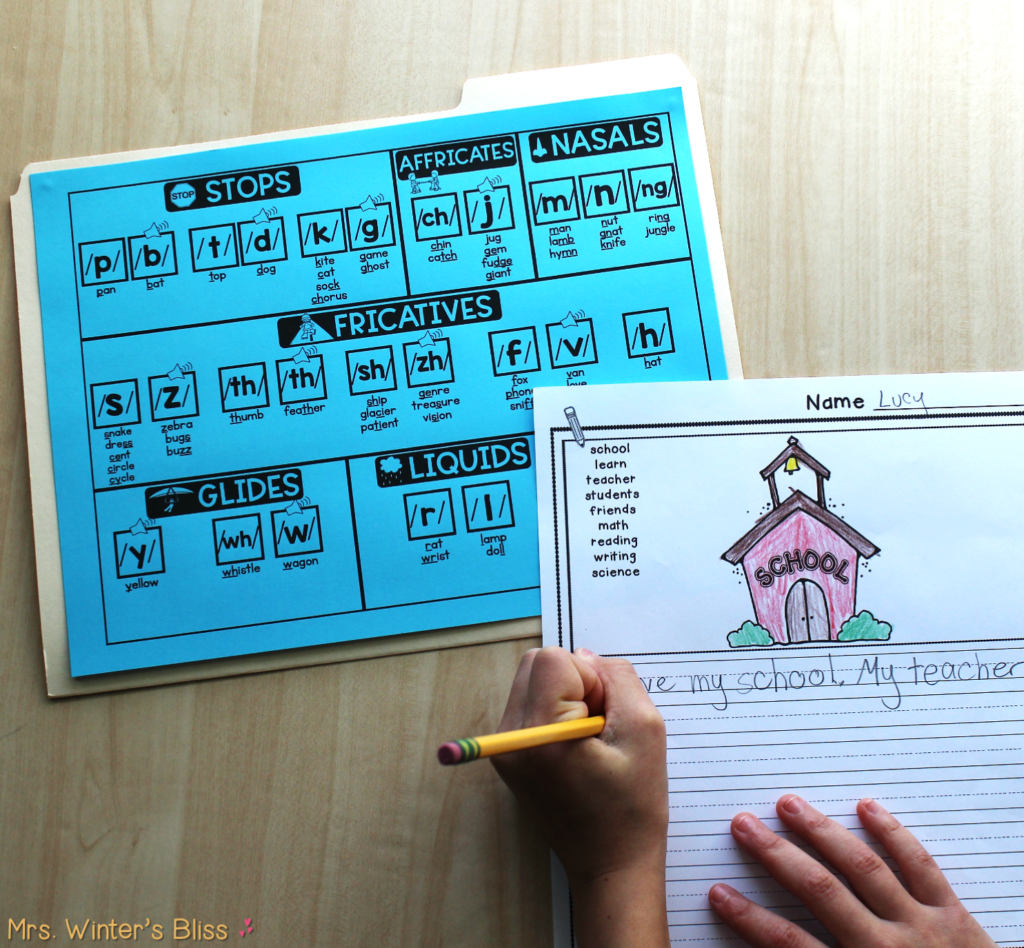
The student materials include:
- Vowel Valley Chart (2 versions)
- Consonant Chart (2 versions)
- A-Z Sound Spelling Chart for student folders
- Alphabet Chart (color and b/w)
- My ABC Dictionary

I love this resource because it has everything (and more!) you need to get a sound wall up and running in your classroom. The only thing you need to do is print the materials, cut and laminate, if you wish!
I felt that by taking my word wall off the wall and replacing it with a sound wall was giving my students a more useful tool. If you still use a traditional word wall but it feels more like a classroom decoration, or you just want to improve your phonics and writing instruction, I encourage you to give a sound wall a try. It is a tool that will transform instruction and help your students grow as readers and writers.
-SHOP THIS POST-
-
Phoneme Sound Wall with Mouth Articulation Photos – science of reading aligned
Product on sale
$28.00
Rated 5.00 out of 5 based on 18 customer ratings
–PIN for LATER–
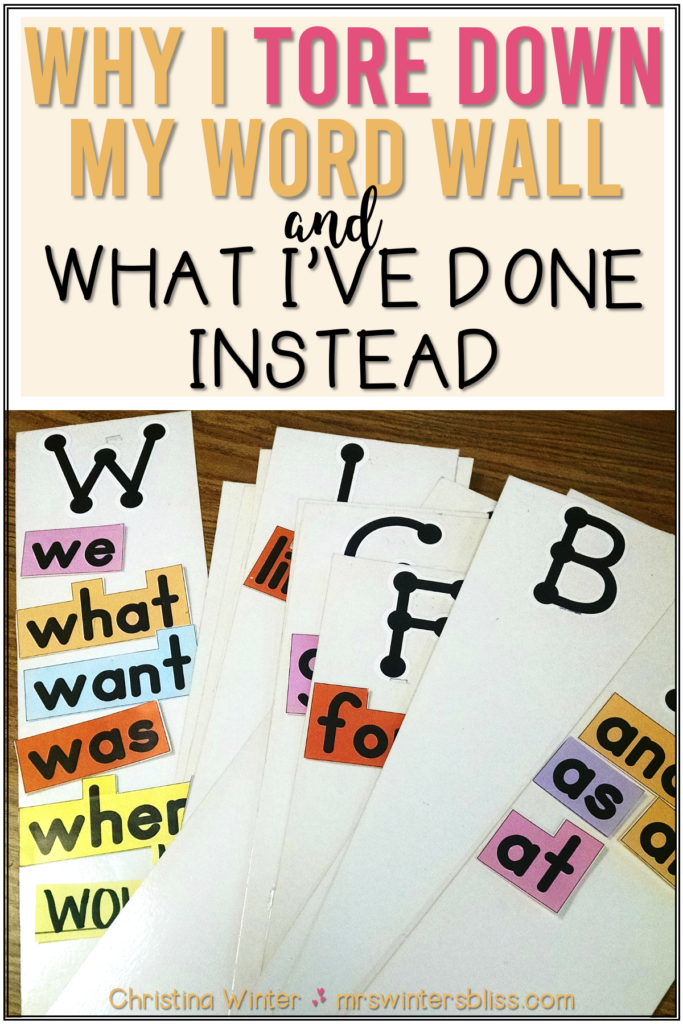
If you have always wanted to have a word wall in your classroom, but were not sure how to begin, we can help. Word walls or displays are a great way to encourage vocabulary development and reinforce language skills. Whether you have an entire wall or a simple pocket chart to devote to it, a word wall can work in any classroom. Try the tricks below to get you started this school year!
Word Wall Basics
Cumulative vs. Work in Progress
Contrary to what some may believe, word walls are not cumulative displays of words learned throughout the year. Instead, they are a place to store new vocabulary from current lessons. Take key vocabulary words from stories being read, history lessons being taught and science experiments being conducted and place them on the word wall. As the lessons and stories change, so too should the words on display. Do not feel locked into having the same words displayed all year long, as that is not the true purpose of a class word wall.
Upon Mastery
Once words have been mastered, they can be transferred to a either a cumulative vocabulary board or placed in a file box word bank. Students should also have a record of the words that were displayed, either in a word journal or in their own file box word bank. Some teachers then use the past words for games of Bingo or other brain teasers. You can also pull words and use them as creative story starters for morning writing.
Materials Needed
Word walls can be as simple or as complex as you make them. For the simplest word wall, use a sentence strip pocket chart where you can cut the words to size, slip them into the pockets and display it at the front of the class. If you have more wall space for displays, place the letters of the alphabet in a row and display the current word wall words below the corresponding letters. If there is no board space or wall space available, hang a clothesline across the room and clothespin the words to the line. Write the words on brightly colored sentence strips or on large, pre-made shapes. Make sure that the words are so clearly written that students can see them from across the room.
Do you use a word wall in your classroom? What do you find to be the most effective way to introduce new vocabulary to your students?
Share your ideas below or on the Really Good Teachers Forums! We’d love to hear how you do it!
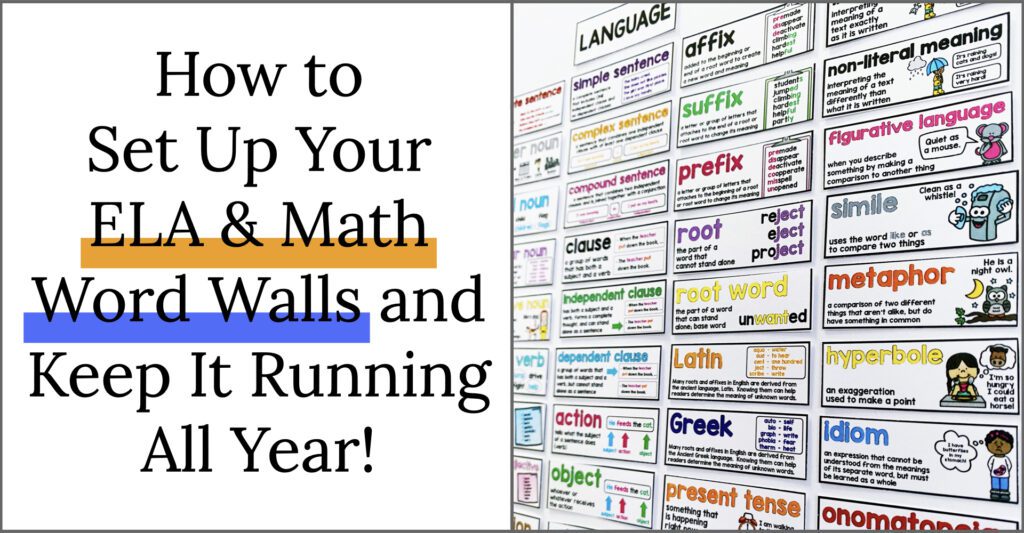
Word walls are alive. They are dynamic features of our classrooms that our students constantly and consistently use. Their existence fosters ownership and independence.
Yet, creating a functional word wall is not as simple as laminating some terms and putting them on the wall. Take it from my own experience! For several years, I noticed that my word walls were getting lost in the background of my classroom. And worse, for some kids, they were visual distractions! That’s when I decided to rethink how I use my word wall, with a focus on usability that kept my students’ needs in mind. After switching classrooms and grade levels numerous times, I’ve had to think through (and think through again) how to best set up my ELA and math word walls as helpful, interactive visual supports and I’ve finally found the perfect balance.
Every classroom (and teacher!) is different. But today, I am so excited to share how I set up my ELA and math word walls so that they are used (and useful) all year long.
Start with a Clean Slate
Switching to a “clean slate” revolutionized how my word wall functioned. It became a dynamic, interactive feature of the classroom!
It is essential to introduce words with purpose. At the start of the year, terms on the wall have little meaning to the students in my room. They don’t know why they are there and might not even know what they mean.
Before the year begins, I create and label designated spaces for both my ELA and my math word walls. I choose wall space that is close to other related resources or manipulatives, therefore students see a space created specifically for word study. They know that it will be a part of the curriculum without a visual and mental overload. At this point, and for some time following, there are no words on the walls.
If I want a word wall to be functional, I need to be deliberate about how I use it and talk about it. That is why I decided that the best way to present my word wall was to build it slowly. I introduce the wall itself at the beginning of the year, then, progressively teach each term when they become needed. When we add a new word, the room is buzzing with excitement. Because students have interacted with the term repeatedly within authentic contexts and eventually put the word up themselves, students develop a sense of pride and excitement.
What if I have limited wall space? Do I keep all the words on the wall?
You don’t have to! Some classrooms are too small to do this. There have been times when including every word from every standard on my word wall was impossible.
Limited wall space calls for a rotating word wall. In this model, words connected to current units of study remain on the wall, while the rest go back into my word wall organizer.
Sometimes I also keep a few “review” words. These are words that we won’t use as frequently, but students have difficulty remembering.
Quick tip: Don’t want to let go of those words as a visual support? Create an individual word wall on a binder ring that is available at your centers! These can also be a great tool for emerging bilinguals or students on IEPs.
Math Word Wall (Grade 2)
Help your 2nd grade students remember these essential math vocabulary terms with this visual math word wall, while brightening up your classroom at the same time! Included are 121 visual math vocabulary cards for the ENTIRE YEAR.
Split Your Word Walls in Two
One word wall is excellent, but two is even better.
My secret weapon for teaching vocabulary is teaching with my word wall cards. I keep them organized and close to me, ready to be pulled out when it is time. In whole group lessons, I teach each word. I show the card, say the word, and continue using the word within the context of our learning.
Spoiler alert: I don’t put it up on the big wall just yet!
After teaching the word (or words), I keep reviewing it throughout a few lessons, which can sometimes mean a whole week. I use them in whole group lessons first, then as needed I incorporate them into my small group centers. With repetition and multisensory usage, my students slowly integrate the word(s) into their own working vocabulary.
Although I wait to put words on the wall, they have a visible, temporary home that is prominent and easy to access (for both students and teachers).
I chose to create that small space in my meeting area– a particular spot for “focus words.” Some years these terms are located on a separate easel for lessons, and other years they can be found on the meeting board.
Each week, I put up a few new terms that will appear in our lessons and activities. Keep this limited! I’ve noticed that the more words I add, the less attention they receive.
Once I notice many students using the term with some independence, it is time for the wall! To begin, I teach the process of adding a word to the wall. I gather everyone in the meeting area and exclaim, “We gained a word!” After a celebratory moment, students watch as I move the word from its temporary home to the word wall itself. My students love the feeling of “gaining” new words to the wall, and with enough emphasis, they know that word is there to use.
Next, it is my students’ turn! Once we have set up our organization system and practiced the routine, I have students add the words to the wall. When students add the words themselves, they are empowered to use the words more and more. The terms are so much more than a decorative reference. I will note: We always follow this routine as a whole group (never individual students or small groups).
By the end of the year, your students have walls of words they have learned, reviewed, and used. It is a physical representation of their hard work and continuous learning throughout the year!
Remember: You want your word walls to be interactive and seen as a resource, not a place for “done” words. Keep going back to the words. Even once they make it to the big wall, incorporate this space and the terms into your lessons. Continuous practice and reference are crucial for students to continue seeing the wall as a resource. Some ways to keep this space interactive include:
- Make it a game: Students find words that match definitions in morning meeting
- Teach in front of the wall!
ELA Word Wall (Grade 3)
Help your 3rd grade students remember these essential English Language Arts vocabulary terms with this visual ELA word wall, while brightening up your classroom at the same time. Included are 229 visual ELA vocabulary cards for the ENTIRE YEAR.
Organize, Organize, Organize
A well-run, well-used word wall comes down to one word: Ownership.
Students need to know that this part of our classroom is available and a community-created resource for them to use.
A big part of that: Students need to really understand the organizational system of the words to find the words they need. And the best way to do that is: Let the kids help!
When students help decide on how to organize the terms, three powerful things happen:
- Students help you understand what works best for them
- They understand the organizational system of the word wall because they created the system
- Students feel ownership over the word wall and are more connected to the visual supports in the classroom.
The process of organizing our word wall is similar to the process of creating class agreements. We discuss and decide as a community. First, we talk about how the organization helps us know how to find things. The kids always have a lot to say!
Then, I show students examples of different methods of organizing the words: either alphabetically or topical (by strand). We talk about the merits of each system. I make sure that we answer the question: Why would each kind of organization be helpful? During this stage, I invite students to share organization systems that help them. They often include library systems and systems from home (i.e., kitchen drawers), and we discuss how different organizational systems can be useful in different spaces.
Math Word Wall (Grade 1)
Help your 1st grade students remember these essential math vocabulary terms with this visual math word wall, while brightening up your classroom at the same time! Included are 133 visual math vocabulary cards for the ENTIRE YEAR.
In the end, the students vote on how we will organize our terms throughout the year. The idea: choosing a system that best fits the majority of the community.
I hope this helps you take a step into your classroom and reimagine how your classroom community looks! I know many of you have had other great successes with word wall! Have a strategy that works well in your classroom community? Share it with us!
5965 результатов для ‘space’
Space
Диаграмма с метками
Space
Диаграмма с метками
Дошкольник
1-й класс
2-й класс
English
Space
Анаграмма
4-й класс
English
FamilyandFriends4
Space
Викторина «Игровое шоу»
Planets
Совпадающие пары
4-й класс
5-й класс
Среднее образование
Go Getter 2
Go Getter 3
planets
space
природные науки
физика
Space
Диаграмма с метками
Дошкольник
1-й класс
2-й класс
English
Space
Сопоставить
5-й класс
6 класс
7-й класс
8 класс
9-й класс
10-й класс
11 класс
Средняя школа
Среднее образование
Техническое / профессиональное образование
Высшее образование
English
Do you use a Word Wall? I think that a Word Wall is an essential part of a primary classroom and WELL worth the wall space that it takes up. There has been a lot of debate in recent years about the merits of a Word Wall. I feel strongly that it is a necessity, but I also feel strongly that it is only beneficial if you TEACH kids how to use it.
This is the first post in a multi-post series about how I set up my word wall, my daily routines and how I practice, practice, practice so my students learn these words.
Deciding on the Words
First off, you may wonder how I decide on my words. Our school board does not dictate our literacy programs, so I don’t have a series I have to follow. I use word lists from different resources: Dolch word lists and the PM benchmark texts to determine the order I introduce the words. There are many resources out there that are helpful. Check with staff at your school to determine if there is a specific list you need to use.
I have a set of word wall cards that I have had for years. The words are different colours and cut to show the shape of the word so that students can easily notice what I call «tall, tummy and dangly» letters. Having different colors makes it easier to help your students locate the word on the word wall with just the cue of «look for the purple word under D for Dinosaur.» Being able to prompt students with colour cues as well as animal clues for the particular letters is very helpful for many of your beginning grade 1 and kindergarten students.
I am also intentional about my letter headers on the Word Wall. I have taught Grade 1 for almost 20 years now, and it is only recently that I made a change on my Word Wall that has saved my teacher sanity. At the beginning of the year a lot of, my students struggled to find a word because they did not have their letter/sound associations solidified. The letter card didn’t provide any help when you said to look under D, because they didn’t necessary know what a D looked like. I decided to create my own header cards (and name tags and alphabet cards, too) with an animal on it so that the those kids could develop an association for the letter. This has worked like a charm. What was even better was their Name Tag had a miniature version of the Alphabet Posters which matched the Word Wall headers.
When talking to my students, I can say «D like Dinosaur,» and they can find the word all by themselves no matter where they look in the classroom. It has seriously been life changing having that picture clue and having all the related resources matching. You can find these Header Cards and all the coordinating pieces by clicking on the image below, which will take you to my TPT Store.
Choosing your Location
There has been a lot of debate in the last few years about what a Word Wall should look like as well as should teachers even use valuable classroom space to have one. Obviously, I am in the camp that says they are essential, but as educators, we need to decide what it will look like in our classrooms.
You need to consider a few things: Do I have a wall space that will work? Will it be accessible to all my students? Can they see it from their workspaces easily?
I have always had a traditional Word Wall on a large wall space. I like to ensure that there is lots of space for the words since I usually have close to 100 words on my wall by the end of the year. This is what it would typically look like at the beginning of the year.
When I talk about the Word Wall being accessible for all I mean a few things. I like to ensure that students can see the Word Wall from any workspace in the classroom. We have tables in our room, and they are all positioned in proximity to the Word Wall. Students often come and stand in front of it to get a closer look, and I am always happy to take a word down for a student to use.
I follow the same routine each week and my students get used to my established routines when it comes to adding words and the Word Wall. I try my best to use the Word Wall for teaching every single day. As we all know, things don’t always go as planned in the classroom and the best laid plans get set aside. At the beginning of the year it is really important to carve out time everyday to use the Word Wall with your students so, if you are lacking time later in the year, they have a good understanding of how to use it.
A word wall is just a bulletin board unless you build it with your students and teach them how to use it.
Check out my Word Wall Pinterest board which shows some of the other options you can use for setting up your word wall.
Are you ready to read about how I teach my kids to read and spell rule breaker words? Click on the image below to find out more about the Word Jail and the Doghouse.
Are you interested in learning more about how we actually practice daily? Click on this image to head over to that post.
Don’t forget to pin this post!

